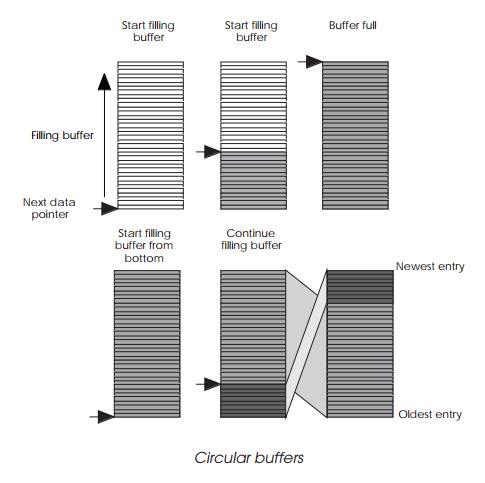Chapter: Embedded Systems Design : Buffering and other data structures
FIFOs and Circular buffers
FIFOs
FIFOs or first in, first out are a special form of buffer that uses
memory to form an orderly queue to hold information. Its most important
attribute is that the data can be extracted in the same way as it was entered.
These are used frequently within serial comms chips to hold data temporarily
while the processor is busy and cannot immediately service the peripheral.
Instead of losing data, it is placed in the FIFO and extracted later. Many of
the buffers described so far use a FIFO architecture.
Their implantation can be done either in software or more commonly with
special memory chips that automatically main-tain the pointers that are needed
to control and order the data.
Circular buffers
Circular buffers are a special type of buffer where the data is
circulated around a buffer. In this way they are similar to a single buffer
that moves the next data pointer to the start of the buffer to access the next
data. In this way the address pointer circulates around the addresses. In that
particular case, care was taken so that no data was lost. It is possible to use
such a buffer and lose data to provide a different type of buffer structure.
This is known as a circular buffer where the input data is allowed to overwrite
the last data entries. This keeps the most recent data at the expense of losing
some of the older data. This is useful for capturing trace data where a trace
buffer may be used to hold the last n
data samples where n is the size of
the buffer. By doing this, the buffer updating can be frozen at any point and
the last n samples can be captured
for examination. This technique is frequently used to create trace and history
buffers for test equipment and data loggers.

This circular structure is also a very good match for coeffi-cient
tables used in digital signal processing where the algorithm iterates around
various tables performing arithmetic operations to perform the algorithm.
The only problem is that the next data pointer must be checked to know
when to reset it to the beginning of the buffer. This provides some additional
overhead. Many DSPs provide a special modulo addressing mode that will
automatically reset the address for a particular buffer size. This buffer size
is normally restricted to a power of two.
Related Topics